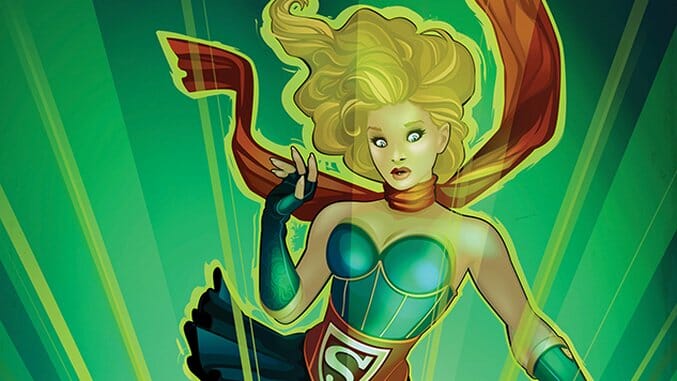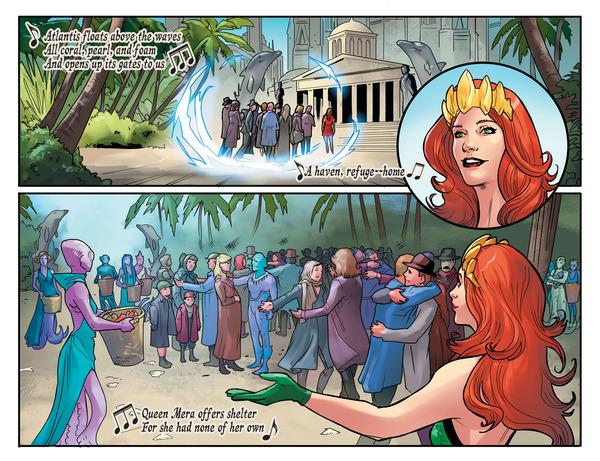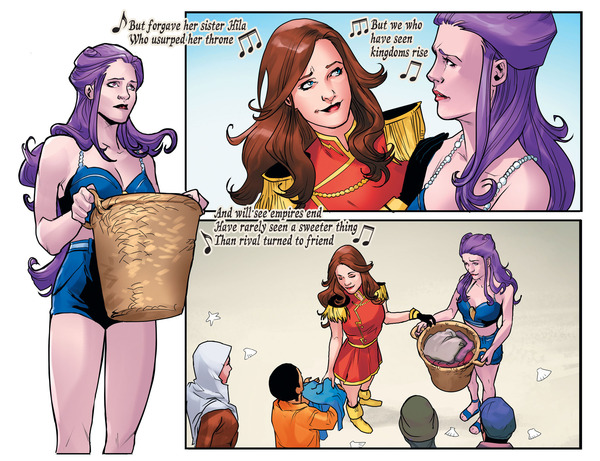Exclusive Preview & Interview: Marguerite Bennett Sings in the New Year with Lyrics-Only Bombshells Chapter
Main Art by Art by Carmen Carnero and Richard Ortiz Comics Features Marguerite Bennett
The latest lyrical chapter of DC Comics Bombshells shouldn’t come as a huge surprise for fans of writer Marguerite Bennett. The scribe also pens the musical adventures of Josie and the Pussycats for Archie and, by her own admission, “can’t deal with silence at all.” Bennett and the art team of Carmen Carnero and Richard Ortiz take that song-centric approach a step further with the 76th chapter, which is solely narrated via lyric.
Conveying notes and rhythms via sequential art is no easy feat (an exercise we’re more than familiar with at Paste), but Bennett weaves a lilting, melodic experience with this alternate-reality take on the DC Universe circa World War II. Initially based off artist Ant Lucia’s line of statues, the concept merges the aesthetic of George Petty’s pinups with J. Howard Miller’s iconic “We Can Do It!” portrait of Geraldine Doyle/Naomi Frayley. In other words, the comic features ‘40s renditions of DC’s heroines kicking all manner of Nazi ass. This entry offers a breather as the series edges toward its end, with refugees given refuge and lovers taking a reflective moment before the New Year.
Paste exchanged emails with Bennett to dive into the process of this innovative project. Check out exclusive art from the comic below. DC Comics Bombshells Chapter 76 is available for download tomorrow from the DC Comics App, comiXology and other major services.![]()
Paste: DC Comics Bombshells Chapter 76 completely lacks dialogue, narrated by song lyrics, conveyed by musical notes festooning the captions. Tell me about the conception of this approach and its development.
Marguerite Bennett: I wanted us to refocus, take a moment, breathe and attend. This arc is the biggest we have ever done, and is a culmination of many characters and many journeys. I wanted to revisit them, share where they are now, remind the reader of all the places we have been, victories and losses, and where we have still to go. Snatches of conversation, while more economical, didn’t have the sense of gravity and grandeur. I wanted something transcendent, something to harmonize our heroines before the beginning of this grand, unifying arc—I wanted a song.

DC Comics Bombshells Chapter #76 Interior Art by Carmen Carnero and Richard Ortiz
Paste: Why was it necessary to articulate this as a song as opposed to poetry?
Bennett: One of the major inspirations for DC Bombshells as a comic was the art and media of the era—the ‘40s, yes, but the ‘20s and ‘30s that went into them. The music of the ‘40s was so defining—the USO shows, the slow dances between lovers, the secret radios, the banned records, the folk songs of defiant peoples, the chants of rebels going out to meet their enemies. Miriam had to sing us a song.
Paste: By design, each “song” that accompanies this comic will range from reader to reader, up to their own imagination and interpretation. I’m assuming it’s one single track, performed by one artist, that runs through the entire comic as the font and style of the lyrics remain continuous. What band/musician plays in your head along with these lyrics? (I’m thinking Sufjan Stevens circa Michigan or maybe Agnes Obel, insofar as the tone and serif/heavy-stroke font is involved.)
Bennett: In my head, there are minor variations—a different instrument, a flourish of flute or drum—while the tune remains the same. Before the boardwalk, I imagine a flutter of calliope music to bring us back to the home front—in the opening page, I imagine the long slow sweet overture of a solitary violin before the song begins, building in strength and pace until Miriam names herself and, in a flash, lights us on our way through the adventure. I composed (badly) a tune for my own use, and would love—perhaps if there is ever a DC Comics Bombshells animated film, for example—to see the song (and story) come to life.

DC Comics Bombshells Chapter #76 Interior Art by Carmen Carnero and Richard Ortiz
Paste: What considerations went into the storytelling of a script intended as a song interlude? Was the creative process any different for artists Carmen Carnero and Richard Ortiz?
Bennett: Actually, this is the kicker—I gave those wonderful gentlemen a silent script. There wasn’t a hint of dialogue OR song in the document they received. I knew the song was coming, but I wanted to be influenced by their art, and not burden them with working around me. They have such an excellent sense of the characters, and I wanted the song to be a dedication to the heroines, not a dictation.

DC Comics Bombshells Chapter #76 Interior Art by Carmen Carnero and Richard Ortiz
Paste: We released a sample of your 200-track playlist for Bombshells a year and a half ago, and what struck me was the diversity of genre—ranging from Rammstein to Sufjan to Sinatra and the Kronos Quartet. In those ten months, has the “sound” of the comic series transformed at all? Have any additional artists risen to represent its aesthetic and themes?
Bennett: Y’all are amazing. And yes, a lot of music has come into this
1. “S.O.S.” by Portishead has this eerie Joker’s Daughter element, conniving for Zatanna or Raven.
2. “National Anthem” from The Gaslight Anthem, for me, is about Batwoman’s fears of failure.
3. “Roxanne” from the Moulin Rouge! soundtrack was a big Catwoman song in the writing, and a certain red thing she may or may not be wearing.
4. “Into the West,” by Annie Lennox from The Lord of the Rings soundtrack is my Wonder Woman song, from Ch. #67 (and Issue #23) as she speaks of death in that single, stand-alone chapter that is likely the most sincere thing I have ever written.
5. “Angel on Fire” from Antony and the Johnsons, in all elements of sacrifice and isolation, the knowledge that to save those you love, you may be forever parted from them—not merely in death, nor distance, but changing an element of yourself so that they no longer recognize what they loved in you.
6. “Frühling in Paris” by Rammstein, not for the corruption of innocence, but for that experience and understanding are not evils, and that there is no shame in a scar.
7. “The Beast” by Austra is the Raven song for the upcoming arc, and all the heights and struggles ahead for her.
8. “Mother Earth and Father Time,” a lullaby from Charlotte’s Web that I loved as a child, and which is the song played when a heroine is in doubt and in need of comfort and reassurance.
9. “Blackstar,” the darkly glorious swansong from David Bowie, that will encompass a massive battle still to come.
10. “Who Lives, Who Dies, Who Tells Your Story?” from Hamilton is, I hope, self-evident.

DC Comics Bombshells Chapter #76 Interior Art by Carmen Carnero and Richard Ortiz
Paste: You’ve also mentioned that you can’t “deal with silence.” Is this an approach you take with all of your comics, or does Bombshells lend itself to a more musical interpretation?
Bennett: DC Comics Bombshells definitely gives me the most canvas on which to work! The scope of the story is massive, and we can leap from genre to genre—war story to romance to propaganda to adventure to horror to coming-of-age—which allows me to rig up a variety of different songs. While songs, poems, chants, etc, feature in just about every series I’ve worked on, Bombshells definitely takes the thickest, fluffiest, most delicious cake.
Paste: From a storytelling perspective, this chapter embraces a calm-before-the-storm pause. From a macro perspective, how does this story—featuring a reprieve for Polish refugees, forgiveness and bonding between characters including Ivy and Harley Quinn—fit into the macro perspective of DC Comics Bombshells? How does this innovative format complement that perspective?
Bennett: I hope it gives us pause and lets us understand that every global conflict exists at varying levels. We have been close in with individual characters, and expanded to see how their actions affect the world. We remember that the change they render comes from their own stories, their own choices—that each person possesses a responsibility to build and create the world in which we all shall live—and our children, and our children’s children, if we are lucky enough to survive.
